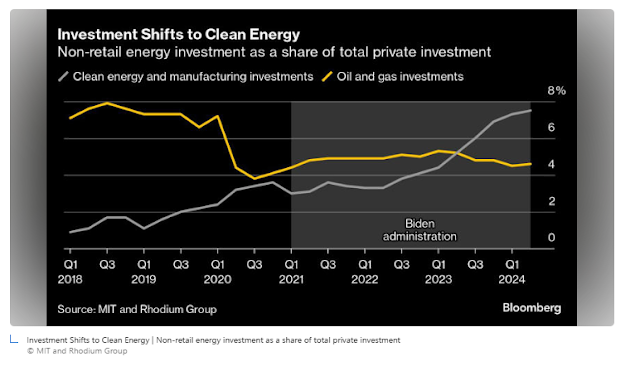Bloomberg just
published an article touting Biden’s climate and clean energy legacy, which is
clearly record-breaking, while also noting that Harris was keeping relatively
quiet about it to allay concerns from swing-state voters about it being too
much spending for too little return. The government investment in clean energy
in the Bipartisan Infrastructure Act and the Inflation Reduction Act have led to
massive private investment in clean energy projects. The graph below shows how
private investment in clean energy has grown while the private investment in
oil & gas that dropped off during Covid has not recovered from 2020 levels.
This does not mean more oil & gas investment is not needed but suggests
that less will be needed in the future, especially when clean energy can actually
make up the full amount of the growth in energy needed annually, which has yet
to occur.
Biden’s
climate/clean energy legacy is huge and shows that he delivered for the climate
change voters and perhaps we should acknowledge that that is enough
incentivization for now. Thus, Harris can pivot to other issues that resonate
more with voters than climate action, which is really not that high on most
voters’ concerns. Bloomberg notes:
“Just 3% of registered voters in seven battleground
states say climate change is the most important issue for them this November,
according to a Bloomberg News/Morning Consult poll taken in late August. Only
39% say climate is “very important.”
Up to 90% of
those private investments associated with the IRA went to red-leaning areas,
according to E2 as the graph below shows.
Bloomberg
considers that Kamala Harris is well aware of how backlash to a green energy
agenda can hurt her campaign. Perhaps enough has been invested for now? The
Biden clean energy investment boom graph is shown below.
As the graph
below shows, the U.S. is second behind China in CO2 emissions. How much that
will drop in the years to come is not known but we should be able to begin dropping
emissions significantly by 2030. Perhaps in the early-mid 2030s U.S. emissions will
drop below those of India, which are still rising considerably due mainly to coal
use.
The graph
below shows the changes in emissions projections after the IRA. Harris can
confidently say that Biden’s effort on emissions reduction was phenomenal without
having to commit more resources or lobby for more action. Of course, climate
hawks say we need to do more and point out that we would still be behind our
Paris Accord commitments 2030 trajectory. However, many of us think we are good
for now with the IRA’s record-breaking investments. If the GOP comes to power,
either through the presidential election or through control of Congress, there
would likely be attempts to scale back some of the planned spending associated
with the IRA.
References:
Kamala Harris Turns Biden's $493 Billion Climate
Legacy Into a Footnote. Jennifer A Dlouhy and Ari Natter. Bloomberg. September
25, 2024. Kamala
Harris Turns Biden's $493 Billion Climate Legacy Into a Footnote (msn.com)






No comments:
Post a Comment